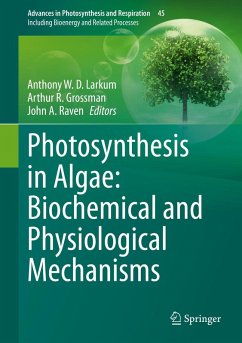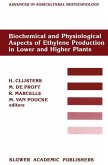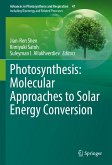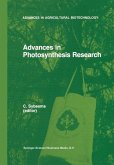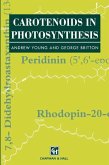Photosynthesis in Algae: Biochemical and Physiological Mechanisms (eBook, PDF)
Redaktion: Larkum, Anthony W. D.; Raven, John A.; Grossman, Arthur R.
167,95 €
167,95 €
inkl. MwSt.
Sofort per Download lieferbar

84 °P sammeln
167,95 €
Als Download kaufen

167,95 €
inkl. MwSt.
Sofort per Download lieferbar

84 °P sammeln
Jetzt verschenken
Alle Infos zum eBook verschenken
167,95 €
inkl. MwSt.
Sofort per Download lieferbar
Alle Infos zum eBook verschenken

84 °P sammeln
Photosynthesis in Algae: Biochemical and Physiological Mechanisms (eBook, PDF)
Redaktion: Larkum, Anthony W. D.; Raven, John A.; Grossman, Arthur R.
- Format: PDF
- Merkliste
- Auf die Merkliste
- Bewerten Bewerten
- Teilen
- Produkt teilen
- Produkterinnerung
- Produkterinnerung

Bitte loggen Sie sich zunächst in Ihr Kundenkonto ein oder registrieren Sie sich bei
bücher.de, um das eBook-Abo tolino select nutzen zu können.
Hier können Sie sich einloggen
Hier können Sie sich einloggen
Sie sind bereits eingeloggt. Klicken Sie auf 2. tolino select Abo, um fortzufahren.

Bitte loggen Sie sich zunächst in Ihr Kundenkonto ein oder registrieren Sie sich bei bücher.de, um das eBook-Abo tolino select nutzen zu können.
This is a unique book on photosynthesis in algae, which does not exist elsewhere
The authors are all world experts in their field
The latest fields of biofuels , bioenergy and whole genomes are dealt with in detail
- Geräte: PC
- ohne Kopierschutz
- eBook Hilfe
- Größe: 18.76MB
Andere Kunden interessierten sich auch für
![Biochemical and Physiological Aspects of Ethylene Production in Lower and Higher Plants (eBook, PDF) Biochemical and Physiological Aspects of Ethylene Production in Lower and Higher Plants (eBook, PDF)]() Biochemical and Physiological Aspects of Ethylene Production in Lower and Higher Plants (eBook, PDF)160,95 €
Biochemical and Physiological Aspects of Ethylene Production in Lower and Higher Plants (eBook, PDF)160,95 €![Organizing the Green World: A Conceptual History of Botanical Classification (eBook, PDF) Organizing the Green World: A Conceptual History of Botanical Classification (eBook, PDF)]() Tod F. StuessyOrganizing the Green World: A Conceptual History of Botanical Classification (eBook, PDF)112,95 €
Tod F. StuessyOrganizing the Green World: A Conceptual History of Botanical Classification (eBook, PDF)112,95 €![Plant Physiological Ecology (eBook, PDF) Plant Physiological Ecology (eBook, PDF)]() Hans LambersPlant Physiological Ecology (eBook, PDF)56,95 €
Hans LambersPlant Physiological Ecology (eBook, PDF)56,95 €![Photosynthesis: Molecular Approaches to Solar Energy Conversion (eBook, PDF) Photosynthesis: Molecular Approaches to Solar Energy Conversion (eBook, PDF)]() Photosynthesis: Molecular Approaches to Solar Energy Conversion (eBook, PDF)191,95 €
Photosynthesis: Molecular Approaches to Solar Energy Conversion (eBook, PDF)191,95 €![Advances in Photosynthesis Research (eBook, PDF) Advances in Photosynthesis Research (eBook, PDF)]() Advances in Photosynthesis Research (eBook, PDF)40,95 €
Advances in Photosynthesis Research (eBook, PDF)40,95 €![Sulfur Metabolism in Phototrophic Organisms (eBook, PDF) Sulfur Metabolism in Phototrophic Organisms (eBook, PDF)]() Sulfur Metabolism in Phototrophic Organisms (eBook, PDF)232,95 €
Sulfur Metabolism in Phototrophic Organisms (eBook, PDF)232,95 €![Carotenoids in Photosynthesis (eBook, PDF) Carotenoids in Photosynthesis (eBook, PDF)]() Carotenoids in Photosynthesis (eBook, PDF)40,95 €
Carotenoids in Photosynthesis (eBook, PDF)40,95 €-
-
-
This is a unique book on photosynthesis in algae, which does not exist elsewhere
The authors are all world experts in their field
The latest fields of biofuels , bioenergy and whole genomes are dealt with in detail
The authors are all world experts in their field
The latest fields of biofuels , bioenergy and whole genomes are dealt with in detail
Dieser Download kann aus rechtlichen Gründen nur mit Rechnungsadresse in A, B, BG, CY, CZ, D, DK, EW, E, FIN, F, GR, HR, H, IRL, I, LT, L, LR, M, NL, PL, P, R, S, SLO, SK ausgeliefert werden.
Produktdetails
- Produktdetails
- Verlag: Springer International Publishing
- Seitenzahl: 514
- Erscheinungstermin: 3. Juni 2020
- Englisch
- ISBN-13: 9783030333973
- Artikelnr.: 59574670
- Verlag: Springer International Publishing
- Seitenzahl: 514
- Erscheinungstermin: 3. Juni 2020
- Englisch
- ISBN-13: 9783030333973
- Artikelnr.: 59574670
- Herstellerkennzeichnung Die Herstellerinformationen sind derzeit nicht verfügbar.
Part 1. Introductory Chapters.- Chapter 1. Recent Advances in the Photosynthesis of Cyanobacteria and Eukaryotic.- Chapter 2. The Algal Tree of Life from a Genomics Perspective.- Part 2. Molecular Genetics Of Algae .- Chapter 3. Chlorophyll-Xanthophyll Antenna Complexes: in between Light Harvesting and Energy Dissipation.- Chapter 4. The Dynamics of the Photosynthetic Apparatus in Algae.- Chapter 5. Biosynthesis of Chlorophyll and Bilins and Assembly of the Photosynthetic Apparatus.- Part 3. Biochemistry and Physiology of Algae.- Chapter 6. Chloroplast Ion and Metabolite Transport in Algae.- Chapter 7. Structural and Biochemical Features of Carbon Acquisition in Algae.- Chapter 8. Light-Driven Oxygen Consumption in the Water-Water Cycles and Photorespiration, and Light Stimulated Mitochondrial Respiration.- Chapter 9. The Algal Pyrenoid.- Part 4. Light-Harvesting Systems in Algae.- Chapter 10. Light-Harvesting in Cyanobacteria and Eukaryotic Algae; An Overview.- Chapter11. Light Harvesting by Long-Wavelegth Chlorophyll Forms (Red Forms) in Algae: Focus on their Presence, Distribution and Formation.- Chapter 12. Diversity in Photoprotection and Energy Balancing in Terrestrial and Aquatic Phototrophs.- Chapter 13. Photoinhibition in Algae.- Chapter 14. Modulating Energy Transfer from Phycobilisomes to Photosystems: State transitions and OCP-related Non-Photochemical Quenching.- Chapter 15. Coherent Processes in Photosynthetic Energy Transport and Transduction.- Chapter 16. Light Harvesting Complexes of Diatoms - Fucoxanthin Chlorophyll. Proteins.- Chapter 17. Symbiodinium, Corals and Coral Bleaching.
Part 1. Introductory Chapters.- Chapter 1. Recent Advances in the Photosynthesis of Cyanobacteria and Eukaryotic.- Chapter 2. The Algal Tree of Life from a Genomics Perspective.- Part 2. Molecular Genetics Of Algae .- Chapter 3. Chlorophyll-Xanthophyll Antenna Complexes: in between Light Harvesting and Energy Dissipation.- Chapter 4. The Dynamics of the Photosynthetic Apparatus in Algae.- Chapter 5. Biosynthesis of Chlorophyll and Bilins and Assembly of the Photosynthetic Apparatus.- Part 3. Biochemistry and Physiology of Algae.- Chapter 6. Chloroplast Ion and Metabolite Transport in Algae.- Chapter 7. Structural and Biochemical Features of Carbon Acquisition in Algae.- Chapter 8. Light-Driven Oxygen Consumption in the Water-Water Cycles and Photorespiration, and Light Stimulated Mitochondrial Respiration.- Chapter 9. The Algal Pyrenoid.- Part 4. Light-Harvesting Systems in Algae.- Chapter 10. Light-Harvesting in Cyanobacteria and Eukaryotic Algae; An Overview.- Chapter11. Light Harvesting by Long-Wavelegth Chlorophyll Forms (Red Forms) in Algae: Focus on their Presence, Distribution and Formation.- Chapter 12. Diversity in Photoprotection and Energy Balancing in Terrestrial and Aquatic Phototrophs.- Chapter 13. Photoinhibition in Algae.- Chapter 14. Modulating Energy Transfer from Phycobilisomes to Photosystems: State transitions and OCP-related Non-Photochemical Quenching.- Chapter 15. Coherent Processes in Photosynthetic Energy Transport and Transduction.- Chapter 16. Light Harvesting Complexes of Diatoms - Fucoxanthin Chlorophyll. Proteins.- Chapter 17. Symbiodinium, Corals and Coral Bleaching.
